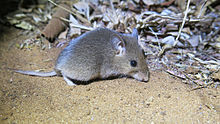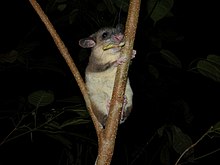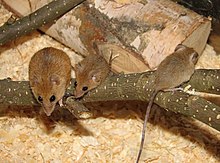Nesomyidae
| Nesomyidae | ||||||||||||
|---|---|---|---|---|---|---|---|---|---|---|---|---|

Island rat, Nesomys rufus |
||||||||||||
| Systematics | ||||||||||||
|
||||||||||||
| Scientific name | ||||||||||||
| Nesomyidae | ||||||||||||
| Forsyth Major , 1897 |

The Nesomyidae are a family of mice with six small subfamilies: the Madagascar rats in Madagascar and the Delany swamp climbing mouse , the African hamster , the African rock mice , the hamster rats and the tree mice in Sub-Saharan Africa . The Nesomyidae are very diverse in terms of size and body structure, behavior, diet and way of life and there are no clear diagnostic features that distinguish them from real mice .
anatomy
The diverse body structure of the Nesomyidae reflects the diversity of their habitats. There are species that resemble rats ( giant hamster rats ), mice ( African climbing mice ), voles ( Madagascar short-tailed rats ) or gerbils ( Madagascar big-footed rats ). The head-torso length varies between 50 and 63 millimeters and 27 to 30 centimeters. The body weight ranges from the Delany swamp climbing mouse , which weighs just six grams, to the giant hamster rats that can weigh up to three kilograms. The tail is variously long or short. It is hairy, naked or with a tassel on the tip and can be designed as a prehensile tail . Usually it is longer than half the head-torso length and naked. The fur is soft and its color is very different. The Nesomyidae have a myomorphic chewing apparatus. In each half of the jaw, they have an incisor tooth and three real molars . A subfamily, the hamster rats, has developed cheek pouches that are outwardly similar to those of the hamsters, but whose retractor muscles differ from that of the hamsters.
Way of life



The Nesomyidae are predominantly herbivores and live on the ground. The more successful specialists among them, mice of smaller body size, however, very skillfully climb blades of grass or thin stems (African climbing mice and other tree mice) or use tiny crevices in desert rocks (African rock mice). The hamster rats as a subfamily, whose body size has increased, compensate for their relatively slow reaction and mobility by using a special strategy when searching for food. With their large cheek pouches, they collect large quantities of food at the safest time, usually at night. In the safe haven they can then feed on their supplies for days.
Tribal history
The ancestor of the Nesomyidae may have reached Africa at the end of the Oligocene . The little mouse was probably a decent climber and initially adapted to the relatively mild climatic conditions of the period. It was probably much more clumsy in its movements and activity than modern rodents like the brown rat . However, their descendants settled most of the habitats in Africa and Madagascar. In Madagascar, like today's Madagascar rats, they became the predominant rodents. In Africa, on the other hand, like most rodents that reached this region relatively early, they are now either highly specialized or, like the Delany swamp climbing mouse, relics on the verge of natural extinction.
The age of the Nesomyidae is supported by paleontological findings. The extinct Afrocricetodontinae, the oldest fossils of the mice in East Africa, are already assigned to the Nesomyidae. They first appear in the Lower Miocene of Kenya, Uganda and Namibia and are represented by the genera Afrocricetodon , Notocricetodon and Protarsomys . The evolutionary origin of individual subfamilies of the Nesomyidae was, with varying degrees of certainty, associated with these and other fossil genera from the Miocene to the Lower Pliocene . The paleontological evidence for such phylogenetic connections, however, is scant and hard evidence from the crucial deposits of the Middle Tertiary is insufficient. Most of the fossil genera of the Nesomyidae are known from localities in sub-Saharan Africa, only for the tree mice there is reliable evidence from the middle Tertiary outside this region.
The relationships between the Nesomyidae and the Cricetodontinae and Myocricetodontinae are unclear . These are said to have reached Africa only 20.7 to 17.0 million years ago, making them contemporary with the Afrocricetodontinae. Finds from Songhor and Rusinga in Kenya date from this period, which indicates either a very rapid expansion or an earlier connection about 23 million years ago. The Afrocricetodontinae probably died out in the Middle Miocene. They were in East and Southern Africa through the Myocricetodontinae with the genera Dakkamys , Mioharimys and Myocricetodon and by Megacricetodontinae replaced. According to Mein et al . (2000), Mioharimys is an ancestor of the African hamster. In the Middle to Upper Miocene, the Democricetodon and Afaromys genera of the Cricetodontinae and the subfamily Namibimyinae occur in East and South Africa .
Systematics and nomenclature
Systematics
The family of the Nesomyidae assigned to the mice is divided into six recent subfamilies. The following illustration of the relationships is based on molecular genetic studies by Fabre and coworkers (2012) and by Schenk and coworkers (2013). The Nesomyidae are also assigned to two fossil subfamilies (†).
| Nesomyidae |
|
||||||||||||||||||||||||||||||||||||||||||
|
|
The archaic Nesomyidae split off from the other species of mice about 25 million years ago. The monophyly of their recent subfamilies has been confirmed by molecular genetic studies and the African subfamilies are also clearly defined morphologically . The Afrocricetodontinae are interpreted as early representatives of the Nesomyidae, while the Otavimyinae are viewed as closely related to the tree mice.
For a long time the Nesomyidae, if they were not included in an all-embracing Muridae family , were divided differently and contradictingly between the Cricetidae and the Muridae. The conceptual origin of the Nesomyidae in today's sense is attributed to Lavocat (1973, 1978), although the content of his family differed from the current composition. However, he identified the individual groups as relics of an occurrence of the Cricetodontinae in the late Oligocene to Miocene of Africa and included them in an expanded definition of the Nesomyidae. Chaline et al. (1977) placed the Afrocricetodontinae and Madagascar rats with the lamellar tooth rats in the family Nesomyidae, the tree mice and the African rock mice in the Dendromuridae and the hamster rats in the Cricetomyidae .
Carleton and Musser (1984) took up the classification of Lavocat and the descent of the Nesomyidae from the Cricetodontinae. They discussed the possibility that today's subfamilies, including the Afrocricetodontinae, should be led as a tribe of the subfamily Nesomyinae in order to better reflect the relationships. As already stated by Lavocat, the African hamster is only a conservative descendant of the Cricetodontinae, to which it resembles in the structure of the molars. A union with the Nesomyinae is clearly preferable to the classification of the Palearctic hamsters . Carleton and Musser also pointed out that the dendromurinae, which at that time also contained the Congo wood mouse in addition to the tree mice , may not be monophyletic. The African rock mice and the Delany swamp climbing mouse, which were run together in the subfamily Petromyscinae, should not have been so closely related and should only have been grouped together due to fewer tooth features. Carleton and Musser also discussed whether the mane rat and the African root rats belong to the Nesomyidae, which Lavocat united with them. They viewed the relationship of the mane rat as unclear, but that of the African root rats they suspected to be in the bamboo rats .
Originally, the expanded definition of the Nesomyidae was based on poor comparisons of tooth features with fossils from the Middle Tertiary . Tong and Jaeger (1993) saw Lavocat's family only as a polyphyletic form taxon , which includes the remnants of evolutionary branches that led to the essential radiation of the Cricetidae or Muridae. Molecular genetic studies (DuBois and coworkers, 1996; Jansa and coworkers, 1999; Michaux and Catzeflis, 2000; Michaux and coworkers, 2001) confirmed the Nesomyidae as a monophyletic group that is basal to the Cricetidae and Muridae. It has also been confirmed that the African rock mice and the Delany swamp climbing mouse are not sister groups and can therefore be divided into two subfamilies.
nomenclature
Charles Immanuel Forsyth Major introduced the subfamily Nesomyinae in 1897. The Nesomyidae appeared for the first time in family rank in 1899 by Tycho Tullberg , and in 1904 by Max Wilhelm Carl Weber . However, these were always only the Madagascar rats.
Additional information

Web links
- Nesomyidae on Animal Diversity Web
literature
- Michael D. Carleton and David CD Happold: Order Rodentia - Rodents . In: David CD Happold (Ed.): Mammals of Africa. Volume III: Rodents, Hares and Rabbits . Bloomsbury, London a. a. 2013, ISBN 978-1-4081-2253-2 , pp. 27-37 .
- Michael D. Carleton, Guy G. Musser: Muroid Rodents . In: Sydney Anderson, J. Knox Jones Jr. (Eds.): Oders and Families of Recent Mammals of the World . John Wiley & Sons, New York a. a., ISBN 0-471-08493-X , pp. 289-379 .
- Jean Chaline, Pierre Mein, Francis Petter: Les grandes lignes d'une classification evolutive des Muroidea . In: Mammalia . tape 41 , no. 3 , 1977, pp. 245-252 , doi : 10.1515 / mamm.1977.41.3.245 .
- Pierre-Henri Fabre, Lionel Hautier, Dimitar Dimitrov, Emmanuel JP Douzery: A glimpse on the pattern of rodent diversification: a phylogenetic approach . In: BMC Evolutionary Biology . tape 12 , no. 88 , 2012, doi : 10.1186 / 1471-2148-12-88 .
- Sharon A. Jansa, Marcelo Weksler: Phylogeny of muroid rodents: relationships within and among major lineages as determined by IRBP gene sequences . In: Molecular Phylogenetics and Evolution . tape 31 , no. 1 , 2004, p. 256-276 , doi : 10.1016 / j.ympev.2003.07.002 .
- Jonathan Kingdon: Mammalian Evolution in Africa . In: Jonathan Kingdon, David CD Happold, Michael Hoffmann, Thomas M. Butynski, Meredith Happold, Jan Kalina (eds.): Mammals of Africa. Volume I: Introductory Chapters and Afrotheria . Bloomsbury, London a. a. 2013, ISBN 978-1-4081-2251-8 , pp. 75-100 .
- Malcolm C. McKenna, Susan K. Bell: Classification of mammals above the species level . Columbia University Press, New York 1997, ISBN 0-231-11012-X .
- Ara Monadjem, Peter J. Taylor, Christiane Denys, Fenton PD Cotterill: Rodents of Sub-Sharan Africa: A Biogeographic and Taxonomic Synthesis . De Gruyter, Berlin a. a. 2015, ISBN 978-3-11-030166-3 .
- Guy G. Musser, Michael D. Carleton: Superfamily Muroidea . In: Don E. Wilson, DeeAnn M. Reeder (Eds.): Mammal Species of the World: A Taxonomic and Geographic Reference . 3. Edition. The Johns Hopkins University Press, Baltimore 2005, ISBN 0-8018-8221-4 , pp. 894-1531 .
- Michael D. Carleton, Guy G. Musser: Family Nesomyidae: Pouched rats and mice, swamp mouse, climbing mice, large-eared mouse, fat mice, white-tailed rat and rock mice . In: David CD Happold (Ed.): Mammals of Africa. Volume III: Rodents, Hares and Rabbits . Bloomsbury, London a. a. 2013, ISBN 978-1-4081-2253-2 , pp. 153 .
- John J. Schenk, Kevin C. Rowe, Scott J. Steppan: Ecological Opportunity and Incumbency in the Diversification of Repeated Continental Colonizations by Muroid Rodents . In: Systematic Biology . tape 62 , no. 6 , 2013, p. 837-864 , doi : 10.1093 / sysbio / syt050 .
- Scott J. Steppan; Ronald M. Adkins, Joel Anderson: Phylogeny and Divergence-Date Estimates of Rapid Radiations in Muroid Rodents Based on Multiple Nuclear Genes . In: Systematic Biology . tape 53 , no. 4 , doi : 10.1080 / 10635150490468701 .
- Terry A. Vaughan, James M. Ryan, Nicholas J. Czaplewski: Mammalogy . 5th edition. Jones and Bartlett Publishers, Sudbury (Massachusetts) 2011, ISBN 978-0-7637-6299-5 .
Remarks
- ↑ a b c d e f g Musser and Carleton, 2013 (p. 153)
- ↑ Monadjem, 2015 (p. 304)
- ↑ a b c d Vaughan and co-workers, 2011 (p. 214)
- ↑ a b c d e Carleton and Happold, 2013 (Tab. 9, p. 36)
- ↑ a b c Kingdon, 2013 (p. 90)
- ↑ a b c d e Monadjem, 2015 (p. 13)
- ↑ Pierre Mein, Martin Pickford, Brigitte Senut: Late Miocene micromammals from the Harasib karst deposits, Namibia. Part 2a - Myocricetodontinae, Petromyscinae and Namibimyinae (Rodentia, Gerbillidae) . In: Communications of the Geological Survey of Namibia . tape 12 , 2000, pp. 391-401 .
- ↑ Fabre and colleagues, 2012 ( Supplement 7 ( Memento of the original from November 18, 2015 in the Internet Archive ) Info: The archive link has been inserted automatically and has not yet been checked. Please check the original and archive link according to the instructions and then remove this note. )
- ↑ Schenk and co-workers, 2013 (Fig. 4, p. 847)
- ↑ Steppan and colleagues, 2004 (Tab. 4, p. 543)
- ↑ a b Schenk and colleagues, 2013 (p. 845)
- ↑ René Lavocat: Les Rongeurs you Miocene d'Afrique orientale. I: Miocene inférieur . In: Mémoires et Travaux de l'Institut de Montpellier de l'Ecole Pratique des Hautes Etudes . tape 1 , 1973, p. 1-284 .
- ↑ René Lavocat: Rodentia and Lagomorpha . In: Vincent J. Maglio, HBS Cooke (Ed.): Evolution of African Mammals . Harvard University Press, Cambridge (Massachusetts) 1978, ISBN 0-674-27075-4 , pp. 69-89 .
- ↑ Chaline and employees (p. 250)
- ↑ a b Carleton and Musser, 1984 (p. 344)
- ↑ Carleton and Musser, 1984 (p. 345)
- ^ Haiyan Tong, Jean-Jacques Jaeger: Muroid rodents from the middle Miocene Fort Ternan locality (Kenya) and their contribution to the phylogeny of muroids . In: Palaeontographica . tape 229 , 1993, pp. 51-73 (p. 56).
- ↑ Jean-Yves Dubois, Daniel Rakotondravony, Catherine Hänni, Patricia Sourrouille, François M. Catzeflis: Molecular evolutionary relationships of three genera of Nesomyinae, endemic rodent taxa from Madagascar . In: Journal of Mammalian Evolution . tape 3 , no. 3 , 1996, p. 239-259 , doi : 10.1007 / BF01458182 .
- ↑ Sharon A. Jansa, Steven M. Goodman, Priscilla K. Tucker: Molecular phylogeny and biogeography of the native rodents of Madagascar (Muridae: Nesomyinae): A test of the single-origin hypothesis . In: Cladistics . tape 15 , no. 3 , 1999, p. 253-270 , doi : 10.1111 / j.1096-0031.1999.tb00267.x .
- ↑ Johan Michaux, François Catzeflis: The bush like radiation of muroid rodents is exemplified by the molecular phylogeny of the LCAT nuclear gene . In: Molecular Phylogenetics and Evolution . tape 17 , no. 2 , 2000, pp. 280–293 , doi : 10.1006 / mpev.2000.0849 .
- ^ Johan Michaux, Aurelio Reyes, François Catzeflis: Evolutionary history of the most speciose mammals: Molecular phylogeny of muroid rodents . In: Molecular Biology and Evolution . tape 18 , no. 11 , 2001, p. 2017–2031 , doi : 10.1093 / oxfordjournals.molbev.a003743 .
- ^ Charles Immanuel Forsyth Major: On the Malagasy Rodent Genus Brachyuromys ; and on the Mutual Relations of some Groups of the Muridae (Hesperomyinae, Microtinae, Murinae, and "Spalacidae") with each other and with the Malagasy Nesomyinae . In: Proceedings of the Zoological Society of London . tape 65 , no. 3 , 1897, p. 695-722 , doi : 10.1111 / j.1096-3642.1897.tb03114.x ( p. 718 ).
- ^ McKenna and Bell, 1997 (p. 157)
- ↑ Tycho Tullberg: About the rodent system: A phylogenetic study . Academic book printing, Uppsala 1899, doi : 10.5962 / bhl.title.1733 ( p. 215 ).
- ↑ Max Wilhelm Carl Weber: The mammals: Introduction to the anatomy and systematics of recent and fossil mammals . Gustav Fischer, Jena 1904, doi : 10.5962 / bhl.title.33699 ( p. 502 ).
- ↑ Musser and Carleton, 2005 (p. 930, Nesomyidae ( Memento of the original from November 18, 2015 in the Internet Archive ) Info: The archive link has been inserted automatically and has not yet been checked. Please check the original and archive link according to the instructions and then remove this note . )